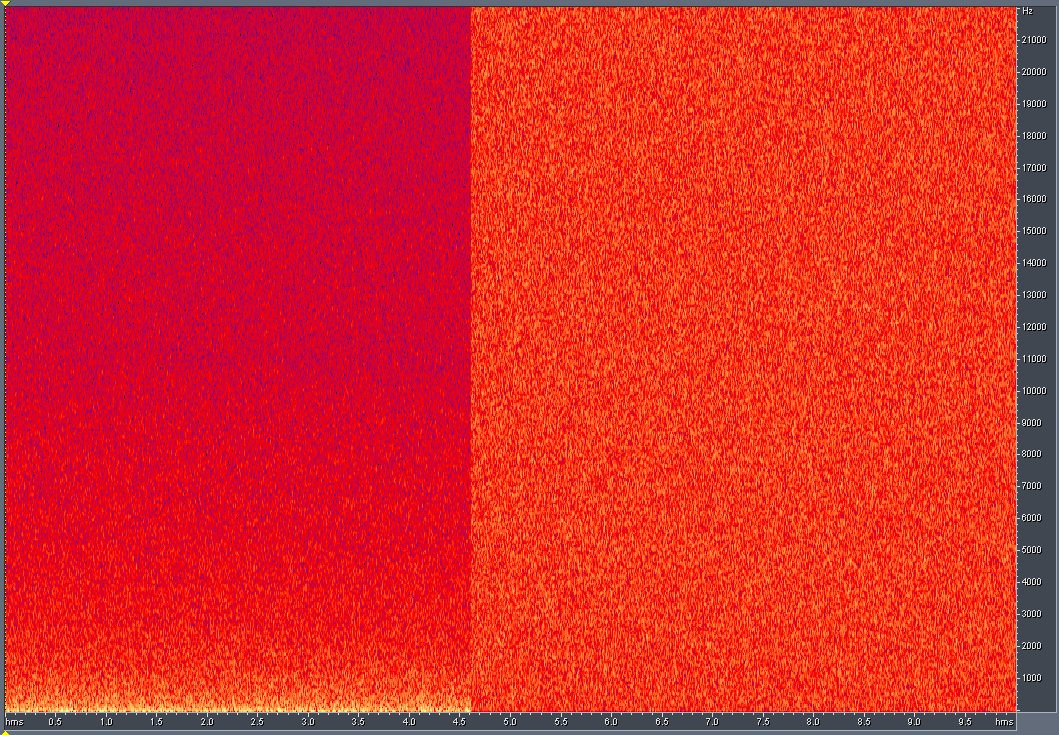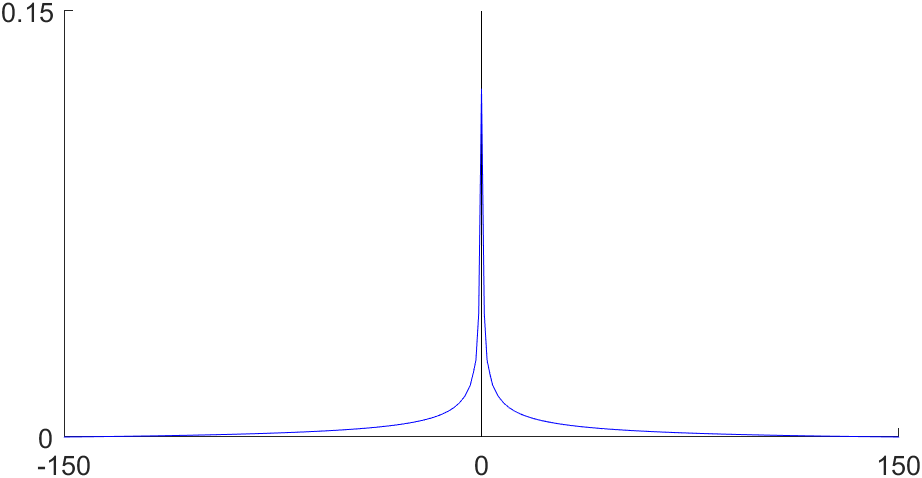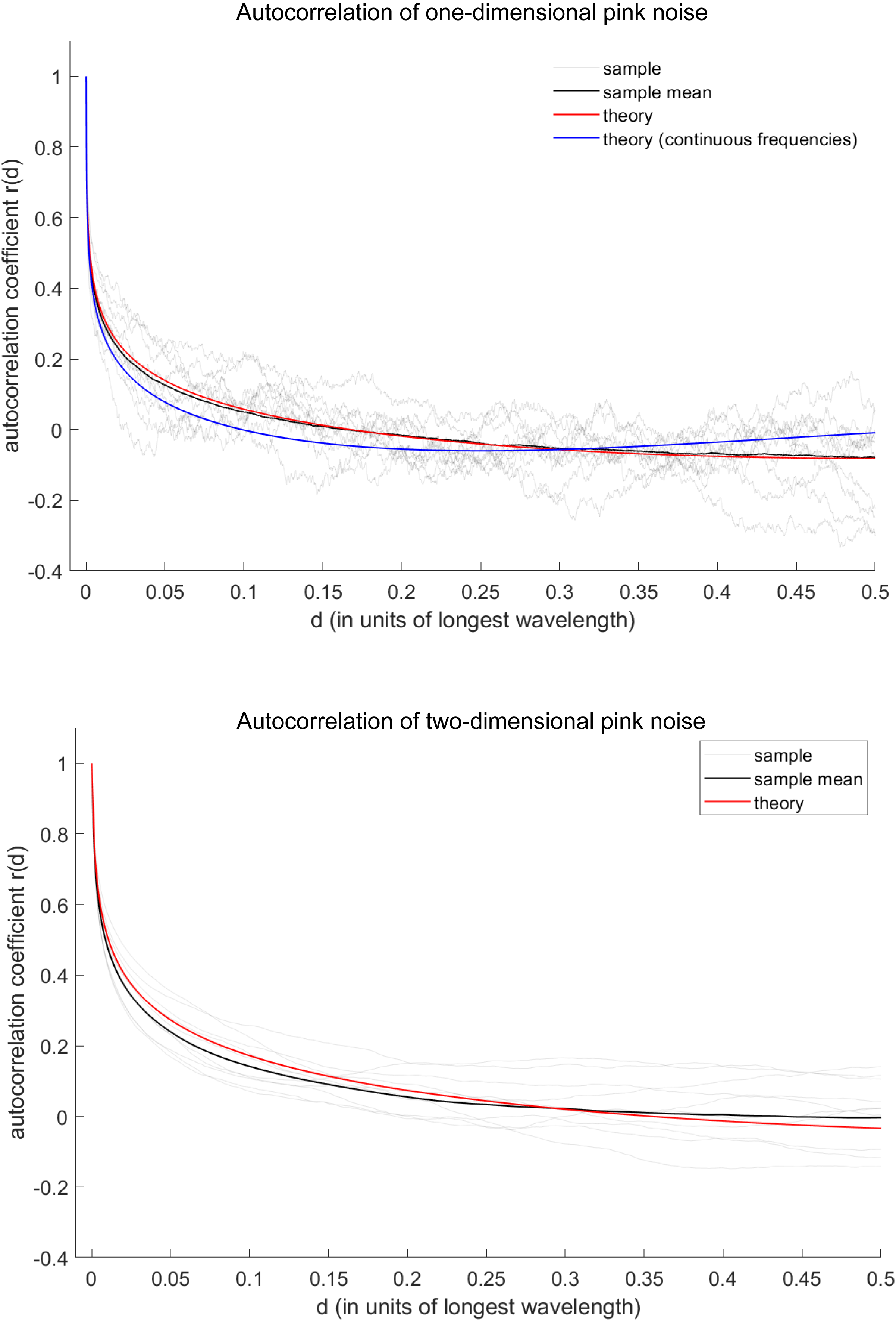
Pink noise, noise, fractional noise or fractal noise is a
signal
A signal is both the process and the result of transmission of data over some media accomplished by embedding some variation. Signals are important in multiple subject fields including signal processing, information theory and biology.
In ...
or process with a
frequency spectrum
In signal processing, the power spectrum S_(f) of a continuous time signal x(t) describes the distribution of power into frequency components f composing that signal. According to Fourier analysis, any physical signal can be decomposed int ...
such that the
power spectral density (power per frequency interval) is
inversely proportional
In mathematics, two sequences of numbers, often experimental data, are proportional or directly proportional if their corresponding elements have a constant ratio. The ratio is called ''coefficient of proportionality'' (or ''proportionality ...
to the
frequency
Frequency is the number of occurrences of a repeating event per unit of time. Frequency is an important parameter used in science and engineering to specify the rate of oscillatory and vibratory phenomena, such as mechanical vibrations, audio ...
of the signal. In pink noise, each
octave
In music, an octave (: eighth) or perfect octave (sometimes called the diapason) is an interval between two notes, one having twice the frequency of vibration of the other. The octave relationship is a natural phenomenon that has been referr ...
interval (halving or doubling in frequency) carries an equal amount of noise energy.
Pink noise sounds like a
waterfall
A waterfall is any point in a river or stream where water flows over a vertical drop or a series of steep drops. Waterfalls also occur where meltwater drops over the edge
of a tabular iceberg or ice shelf.
Waterfalls can be formed in seve ...
. It is often used to tune
loudspeaker
A loudspeaker (commonly referred to as a speaker or, more fully, a speaker system) is a combination of one or more speaker drivers, an enclosure, and electrical connections (possibly including a crossover network). The speaker driver is an ...
systems in
professional audio
Professional audio, abbreviated as pro audio, refers to both an activity and a category of high-quality, studio-grade audio equipment. Typically it encompasses sound recording, sound reinforcement system setup and audio mixing, and studio mus ...
.
Pink noise is one of the most commonly observed signals in biological systems.
The name arises from the pink appearance of visible light with this power spectrum.
This is in contrast with
white noise
In signal processing, white noise is a random signal having equal intensity at different frequencies, giving it a constant power spectral density. The term is used with this or similar meanings in many scientific and technical disciplines, i ...
which has equal intensity per frequency interval.
Definition
Within the scientific literature, the term "1/f noise" is sometimes used loosely to refer to any noise with a power spectral density of the form
where is frequency, and , with exponent usually close to 1. One-dimensional signals with are usually called pink noise.
The following function describes a length one-dimensional pink noise signal (i.e. a
Gaussian white noise signal with zero mean and standard deviation , which has been suitably filtered), as a sum of sine waves with different frequencies, whose amplitudes fall off inversely with the square root of frequency (so that power, which is the square of amplitude, falls off inversely with frequency), and phases are random:
are
independently and identically () chi-distributed variables, and are uniform random.
In a two-dimensional pink noise signal, the amplitude at any orientation falls off inversely with frequency. A pink noise square of length can be written as:
General -like noises occur widely in nature and are a source of considerable interest in many fields. Noises with near 1 generally come from
condensed-matter systems in
quasi-equilibrium, as discussed below.
Noises with a broad range of generally correspond to a wide range of
non-equilibrium Non-equilibrium may refer to:
* generally the absence of an equilibrium
* Non-equilibrium economics
* Non-equilibrium statistical mechanics
* Non-equilibrium thermodynamics
{{disambiguation ...
driven
dynamical system
In mathematics, a dynamical system is a system in which a Function (mathematics), function describes the time dependence of a Point (geometry), point in an ambient space, such as in a parametric curve. Examples include the mathematical models ...
s.
Pink noise sources include ''
flicker noise'' in electronic devices. In their study of
fractional Brownian motion,
and Van Ness proposed the name ''fractional noise'' (sometimes since called ''fractal noise'') to describe noises for which the exponent is not an even integer, or that are
fractional derivative
Fractional calculus is a branch of mathematical analysis that studies the several different possibilities of defining real number powers or complex number powers of the differentiation operator D
D f(x) = \frac f(x)\,,
and of the integration ...
s of
Brownian () noise.
Description


In pink noise, there is equal energy per
octave
In music, an octave (: eighth) or perfect octave (sometimes called the diapason) is an interval between two notes, one having twice the frequency of vibration of the other. The octave relationship is a natural phenomenon that has been referr ...
of frequency. The energy of pink noise at each frequency level, however, falls off at roughly 3
dB per octave. This is in contrast to
white noise
In signal processing, white noise is a random signal having equal intensity at different frequencies, giving it a constant power spectral density. The term is used with this or similar meanings in many scientific and technical disciplines, i ...
which has equal energy at all frequency levels.
The
human auditory system, which processes frequencies in a roughly logarithmic fashion approximated by the
Bark scale
The Bark scale is a psychoacoustical scale proposed by Eberhard Zwicker in 1961. It is named after Heinrich Barkhausen, who proposed the first subjective measurements of loudness.Zwicker, E. (1961),Subdivision of the audible frequency range i ...
, does not perceive different frequencies with equal sensitivity; signals around 1–4 kHz sound
loudest for a given intensity. However, humans still differentiate between white noise and pink noise with ease.
Graphic equalizer
Equalization, or simply EQ, in sound recording and reproduction is the process of adjusting the volume of different frequency bands within an audio signal. The circuit or equipment used to achieve this is called an equalizer.
Most hi-fi eq ...
s also divide signals into bands logarithmically and report power by octaves; audio engineers put pink noise through a system to test whether it has a flat frequency response in the spectrum of interest. Systems that do not have a flat response can be equalized by creating an inverse filter using a graphic equalizer. Because pink noise tends to occur in natural physical systems, it is often useful in audio production. Pink noise can be processed, filtered, and/or effects can be added to produce desired sounds. Pink-noise generators are commercially available.
One parameter of noise, the peak versus average energy contents, or
crest factor, is important for testing purposes, such as for
audio power amplifier
An audio power amplifier (or power amp) amplifies low-power electronic audio signals, such as the signal from a radio receiver or an electric guitar pickup, to a level that is high enough for driving loudspeakers or headphones. Audio power a ...
and
loudspeaker
A loudspeaker (commonly referred to as a speaker or, more fully, a speaker system) is a combination of one or more speaker drivers, an enclosure, and electrical connections (possibly including a crossover network). The speaker driver is an ...
capabilities because the signal power is a direct function of the crest factor. Various crest factors of pink noise can be used in simulations of various levels of
dynamic range compression
Dynamic range compression (DRC) or simply compression is an audio signal processing operation that reduces the volume of loud sounds or amplifies quiet sounds, thus reducing or ''compressing'' an audio signal's dynamic range. Compression is c ...
in music signals. On some digital pink-noise generators the crest factor can be specified.
Generation

Pink noise can be computer-generated by first generating a white noise signal, Fourier-transforming it, then dividing the amplitudes of the different frequency components by the square root of the frequency (in one dimension), or by the frequency (in two dimensions) etc.
This is equivalent to spatially filtering (convolving) the white noise signal with a white-to-pink-filter. For a length
signal in one dimension, the filter has the following form:
Matlab programs are available to generate pink and other power-law coloured noise i
oneor
any numberof dimensions.
Properties

Power-law spectra
The power spectrum of pink noise is
only for one-dimensional signals. For two-dimensional signals (e.g., images) the average power spectrum at any orientation falls as
, and in
dimensions, it falls as
. In every case, each octave carries an equal amount of noise power.
The average amplitude
and power
of a pink noise signal at any orientation
, and the total power across all orientations, fall off as some power of the frequency. The following table lists these power-law frequency-dependencies for pink noise signal in different dimensions, and also for general power-law colored noise with power
(e.g.:
Brown noise has
):
Distribution of point values
Consider pink noise of any dimension that is produced by generating a Gaussian white noise signal with mean
and sd
, then multiplying its spectrum with a filter (equivalent to spatially filtering it with a filter
). Then the point values of the pink noise signal will also be normally distributed, with mean
and sd
.
Autocorrelation
Unlike white noise, which has no correlations across the signal, a pink noise signal is correlated with itself, as follows.
1D signal
The Pearson's correlation coefficient of a one-dimensional pink noise signal (comprising discrete frequencies
) with itself across a distance
in the configuration (space or time) domain is:
If instead of discrete frequencies, the pink noise comprises a superposition of continuous frequencies from
to
, the autocorrelation coefficient is:
where
is the
cosine integral function.
2D signal
The Pearson's autocorrelation coefficient of a two-dimensional pink noise signal comprising discrete frequencies is theoretically approximated as:
where
is the
Bessel function of the first kind.
Occurrence
Pink noise has been discovered in the
statistical fluctuations of an extraordinarily diverse number of physical and biological systems (Press, 1978;
see articles in Handel & Chung, 1993,
and references therein). Examples of its occurrence include fluctuations in
tide
Tides are the rise and fall of sea levels caused by the combined effects of the gravitational forces exerted by the Moon (and to a much lesser extent, the Sun) and are also caused by the Earth and Moon orbiting one another.
Tide tables ...
and river heights,
quasar
A quasar ( ) is an extremely Luminosity, luminous active galactic nucleus (AGN). It is sometimes known as a quasi-stellar object, abbreviated QSO. The emission from an AGN is powered by accretion onto a supermassive black hole with a mass rangi ...
light emissions, heart beat, firings of single
neuron
A neuron (American English), neurone (British English), or nerve cell, is an membrane potential#Cell excitability, excitable cell (biology), cell that fires electric signals called action potentials across a neural network (biology), neural net ...
s,
resistivity
Electrical resistivity (also called volume resistivity or specific electrical resistance) is a fundamental specific property of a material that measures its electrical resistance or how strongly it resists electric current. A low resistivity i ...
in
solid-state electronics
Solid-state electronics are semiconductor electronics: electronic equipment that use semiconductor devices such as transistors, diodes and integrated circuits (ICs). The term is also used as an adjective for devices in which semiconductor elec ...
and single-molecule conductance signals resulting in
flicker noise. Pink noise describes the
statistical structure of many natural images.
General 1/''f''
α noises occur in many physical, biological and economic systems, and some researchers describe them as being ubiquitous.
In physical systems, they are present in some
meteorological
Meteorology is the scientific study of the Earth's atmosphere and short-term atmospheric phenomena (i.e. weather), with a focus on weather forecasting. It has applications in the military, aviation, energy production, transport, agriculture ...
data series, the
electromagnetic radiation
In physics, electromagnetic radiation (EMR) is a self-propagating wave of the electromagnetic field that carries momentum and radiant energy through space. It encompasses a broad spectrum, classified by frequency or its inverse, wavelength ...
output of some astronomical bodies. In biological systems, they are present in, for example,
heart beat rhythms, neural activity, and the statistics of
DNA sequence
A nucleic acid sequence is a succession of bases within the nucleotides forming alleles within a DNA (using GACT) or RNA (GACU) molecule. This succession is denoted by a series of a set of five different letters that indicate the order of the nu ...
s, as a generalized pattern.
An accessible introduction to the significance of pink noise is one given by
Martin Gardner
Martin Gardner (October 21, 1914May 22, 2010) was an American popular mathematics and popular science writer with interests also encompassing magic, scientific skepticism, micromagic, philosophy, religion, and literatureespecially the writin ...
(1978) in his ''Scientific American'' column "Mathematical Games".
In this column, Gardner asked for the sense in which music imitates nature. Sounds in nature are not musical in that they tend to be either too repetitive (bird song, insect noises) or too chaotic (ocean surf, wind in trees, and so forth). The answer to this question was given in a statistical sense by Voss and Clarke (1975, 1978), who showed that pitch and loudness fluctuations in speech and music are pink noises.
So music is like tides not in terms of how tides sound, but in how tide heights vary.
Precision timekeeping
The ubiquitous 1/f noise poses a "noise floor" to precision timekeeping.
The derivation is based on.

Suppose that we have a timekeeping device (it could be anything from
quartz oscillators,
atomic clocks
An atomic clock is a clock that measures time by monitoring the resonant frequency of atoms. It is based on atoms having different energy levels. Electron states in an atom are associated with different energy levels, and in transitions betwee ...
, and
hourglasses). Let its readout be a real number
that changes with the actual time
. For concreteness, let us consider a quartz oscillator. In a quartz oscillator,
is the number of oscillations, and
is the rate of oscillation. The rate of oscillation has a constant component
and a fluctuating component
, so
. By selecting the right units for
, we can have
, meaning that on average, one second of clock-time passes for every second of real-time.
The stability of the clock is measured by how many "ticks" it makes over a fixed interval. The more stable the number of ticks, the better the stability of the clock. So, define the average clock frequency over the interval
 Pink noise, noise, fractional noise or fractal noise is a
Pink noise, noise, fractional noise or fractal noise is a 
 In pink noise, there is equal energy per
In pink noise, there is equal energy per  Pink noise can be computer-generated by first generating a white noise signal, Fourier-transforming it, then dividing the amplitudes of the different frequency components by the square root of the frequency (in one dimension), or by the frequency (in two dimensions) etc. This is equivalent to spatially filtering (convolving) the white noise signal with a white-to-pink-filter. For a length signal in one dimension, the filter has the following form:
Matlab programs are available to generate pink and other power-law coloured noise i
Pink noise can be computer-generated by first generating a white noise signal, Fourier-transforming it, then dividing the amplitudes of the different frequency components by the square root of the frequency (in one dimension), or by the frequency (in two dimensions) etc. This is equivalent to spatially filtering (convolving) the white noise signal with a white-to-pink-filter. For a length signal in one dimension, the filter has the following form:
Matlab programs are available to generate pink and other power-law coloured noise i
 Suppose that we have a timekeeping device (it could be anything from quartz oscillators,
Suppose that we have a timekeeping device (it could be anything from quartz oscillators,
 Pink noise, noise, fractional noise or fractal noise is a
Pink noise, noise, fractional noise or fractal noise is a  In pink noise, there is equal energy per
In pink noise, there is equal energy per  Pink noise can be computer-generated by first generating a white noise signal, Fourier-transforming it, then dividing the amplitudes of the different frequency components by the square root of the frequency (in one dimension), or by the frequency (in two dimensions) etc. This is equivalent to spatially filtering (convolving) the white noise signal with a white-to-pink-filter. For a length signal in one dimension, the filter has the following form:
Matlab programs are available to generate pink and other power-law coloured noise i
Pink noise can be computer-generated by first generating a white noise signal, Fourier-transforming it, then dividing the amplitudes of the different frequency components by the square root of the frequency (in one dimension), or by the frequency (in two dimensions) etc. This is equivalent to spatially filtering (convolving) the white noise signal with a white-to-pink-filter. For a length signal in one dimension, the filter has the following form:
Matlab programs are available to generate pink and other power-law coloured noise i